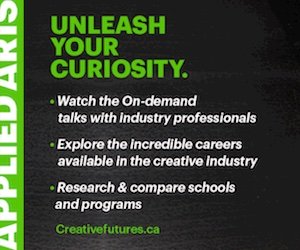Guidance
Are Careers in Advertising Dead? (Hint: NO!)
Careers in advertising aren’t dead. They’re just becoming really, really different
By Suzanne Pope
It’s not an easy time to be a student of advertising. Whatever program you’re in, it is just one of many in Canada. Together, these programs graduate hundreds of students every year, turning them loose to duke it out for a few dozen unpaid internships that, in all likelihood, aren’t even legal.
And the prospects of these students once those internships are done? Let’s turn it over to Ignacio Oreamuno, founder of Portfolio Night and the former executive director of the Art Directors Club (which has merged with The One Club to form the One Club for Creativity) in New York City: “Copywriting and art director career paths are dinosaur careers that, in my opinion, are extinct.”
There. That’s the most depressing thing you’ll read in this article. And now that the Band-Aid has been ripped off, I want to tell you that there are other opinions out there, opinions that I hope you’ll find more reassuring.
Let’s start by talking about what you want. I’m guessing it’s a secure, full-time job. If that is your fondest wish, forgive me, but I’m going to repeat something you’ve probably heard twenty times this week: You should learn to code.
Seriously, when I Googled “You should learn to code,” I got 698 million results. It’s hard to imagine any discipline that’s crying out more loudly for new talent right now. Mike Boyle, a co-founder of Media Platforms in Toronto, has joined in that call. “Developers right now are making huge salaries right out of school with almost no experience,” he told me, “and the employers are the ones competing to hire the best talent. The need for someone sitting at a computer all day, writing lines of code, is only going to increase in our wired society, so the sky is the limit if you’re looking to get into programming.”
Boyle’s prediction is undoubtedly accurate. Therefore, if you want to eliminate your anxiety about getting a job after you graduate, by all means, switch courses and focus on programming. But before you make that change, consider what else was said. As a web developer, you will be sitting at a computer all day, writing lines of code. There are many creative people who have found code to be a gloriously expressive medium for showcasing their imaginations. If you are one of them, your future is set, and you have no need to keep reading. But if you want to become a web developer mainly for the job security, please don’t. I mean it. If you pursue a career that doesn’t make you look forward to Monday, you probably won’t be very good at it. And if that’s the case, your job security will be as shaky as your devotion to your craft.
So, what to do? You’re a creative person who entered a creative program because you wanted to build a career out of your love of making things. You can still do that. But you have to open your thinking to where and how that will happen, because it is becoming less and less likely that you’ll make an advertising agency your forever home.
When I started my career as a copywriter (and when my father before me started his), advertising agencies ruled. They would do the print ads and the TV and radio spots, and that was usually it. And, because they got a commission in the neighbourhood of 15 per cent for buying the print space and broadcast time, many of them were outrageously profitable. Consumer agencies back then didn’t typically sully their hands with less prestigious assignments like promotions, direct mail, brochures or events. Those items got handed off to PR firms, design studios and so-called below-the-line agencies, suppliers who were seen as being way down the food chain. Fifteen years ago, agencies could credibly offer some version of 360-degree branding (as Ogilvy called it) because it was still theoretically possible for them to directly or indirectly supervise every point of contact with consumers.
And then came the Internet. Suddenly, that formerly manageable handful of channels grew exponentially. Companies accustomed to one-way communication with the public now had to engage in public conversations, remaining civil even in the face of abuse from trolls. And, worst of all for old-school agencies, client budgets stayed the same in spite of a greatly expanded scope of work. That old request for a few print ads and a TV spot? It’s turned into an endless demand for this thing called content — Facebook posts, tweets, clickbait articles, Instagrams, zero-budget videos — in short, the kinds of things agencies would have considered beneath their dignity not so long ago.
Today, such assignments aren’t beneath anyone’s dignity. Consumer agencies are now competing for business with the sorts of suppliers they used to view with disdain. And the adjustment hasn’t been easy. As marketing consultant Mark Schaefer heard from a Fortune 100 brand manager, “We want to leverage social media, content marketing and integrated models, but every time we ask our agency for a proposal, it comes back as advertising. I’m sick of it. I am ready to break our contract at any cost because they just don’t get it.”
They just don’t get it.
Though that perception might not be true with every traditional agency, it’s a common enough complaint to give pause to anyone who wants to be in advertising. But, to be clear, the pause shouldn’t be around your desire to make a living through creativity. It should be around where and how you’ll choose to be creative. You might begin in advertising, but that doesn’t mean you’ll stay there.
So, what are your options? There are several.
You can work in-house. In the old world of advertising, it was assumed that people who worked in-house for clients did so because they weren’t good enough to get jobs at “real” agencies. That has completely changed. Huge brands — Google and Red Bull, for example — have produced exceptional work with their in-house agencies. And they are not alone. According to a recent report by the Society of Digital Agencies, 27 per cent of companies no longer work with outside marketing firms — more than double the number from the previous year. This trend will continue. More and more companies will opt for ideas from cost-efficient staff who are intimate with the brand, and whose hours aren’t marked up or divided among multiple clients.
You can work in public relations. In the pre-Internet world, clients would happily pay for their media because it had an excellent chance of being seen by their target. Today, that paid media is easily ignored and increasingly hard to justify. Today, all eyes are on earned media — the messages that cost your clients nothing to push out because news sites, blogs and social media are doing it for them. PR firms have had a head start of almost a century in the discipline of earned media. And in recognition of this reality, many copywriters and art directors who started in advertising are now growing their careers at PR firms.
You can hedge your bets with more education. OCAD University offers a graduate program called Digital Futures, which aims to create what program director Tom Barker calls “X-shaped designers,” ones who are competent in the four disciplines of art, design, programming and enterprise. The graduates of Digital Futures are not trained for any one job, but, rather, for the thousands of innovative roles that don’t even exist yet.
You can create your own job. You might think this is the scariest option. Or you might find it the most exciting. Either way, there has never been a better time for young entrepreneurs to make their mark. Consider 25-year-old Jake Van Buskirk, who graduated from Ryerson University in 2014 with a degree in film production. Today, Van Buskirk is an art director at Leo Burnett in Toronto. But he’s more than that. He’s is something of a modern Renaissance man, someone who considers himself a writer, artist, filmmaker, designer and businessman, all in equal measure. In 2014, Van Buskirk and his business partner Michael Potters launched Parachute Coffee, an online coffee subscription service that offers monthly deliveries of fresh coffee beans from Canadian small-batch roasters. To Van Buskirk, there’s no downside to being an entrepreneur: “Even a failed business attempt can result in 10 job offers along the way.”
I asked him if he considers it a mistake to become an art director or copywriter. He answered no, but with an important caveat: “It’s not a mistake as long as your drive is not reputation, but instead to produce great work. It is a tough world to break into if you haven’t developed yourself as an artist first. Nobody gets into advertising because they love dish soap or a particular barbecue sauce brand. They get into the creative world because they’ve got good taste, they like making art, they like storytelling. And these jobs are the best tools for growing those creative muscles.”
The view that advertising is a brilliant jumping-off point for any creative career is shared by Michael Gelfand and Ian Letts. The two began as an award-winning creative team, but later branched out to become the Perlorian Brothers, who are today among the world’s most sought-after directors of television commercials. As the Brothers told me, “We’d never be able to do what we do without the foundation of working in a creative department. It’s where we learned about having ideas and writing commercials and making commercials and working with clients and having to compromise and fighting for the important stuff and caring about details...basically the stuff that we still have to deal with every working day.”
As for advertising’s volatility, well, this isn’t news. Nancy Vonk spent 13 years as the co-chief creative officer of Ogilvy & Mather in Toronto — where she worked on campaigns such as Dove’s “Evolution” — and today is a partner in the Swim leadership-training program. “The ad agency creative’s career has never been one that meant guaranteed employment until retirement (or, next month),” she told me. “If the business looks kinda scary today, in a very real sense, it always was. Every ‘creative’ industry has many more variables surrounding long-term success than, say, a career in accounting.”
Okay, let’s talk some more about the insecurity of an advertising career. You need to relax about that. Why? Because the insecurity of advertising has now spread to pretty much every industry in the world.
The futurist Mary O’Hara-Devereaux tells us that tomorrow’s workplace will be the site of “Velcro relationships,” rather than full-time employment. You and your employer will bind together tightly for however long your services are needed — a week, a month, a year — and then pull apart without damage when the assignment is done. If this prediction proves accurate, the future will likely turn each and every one of us into freelancers. For some, the arrangement will be wonderfully lucrative, and paying for our own dental work won’t be a problem. For others, this new reality will mean hustling for every pizza coupon and static-banner assignment out there. Bottom line? In the future, the promise of permanent job security will likely be illusory no matter what you do. So, you might as well do the kind of work that gives you a sense of purpose — without worrying so much about the glamour or prestige.
I’m thinking now about that curse that’s always been attributed to the Chinese: May you live in interesting times. Yes, we are definitely living in interesting times, but it won’t be a curse unless you view it that way. For the first time ever in the modern workplace, entry-level workers are more poised for success than those who manage them. Here’s some advice Ignacio Oreamuno gave me to pass on: “Make your new title, find your specialty, and make the future, because it won’t come from high above on the executive floor. They have no idea where things are going, either.”
You might not know what’s next in your career, but that doesn’t mean it isn’t there. If you can write, if you can think conceptually, or if you have a gift for design, you will find work. So please stop worrying.
And start creating.
Suzanna Pope is a Toronto-based freelance copywriter.
This article originally appeared in the November/December 2015 issue of Applied Arts.



